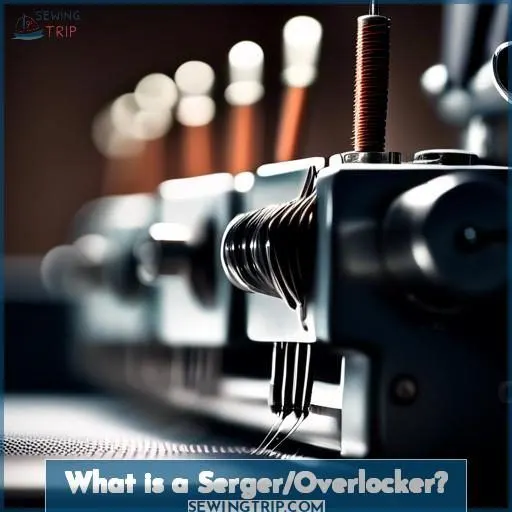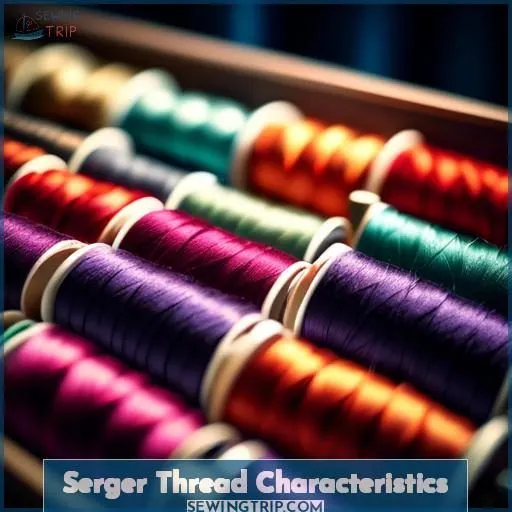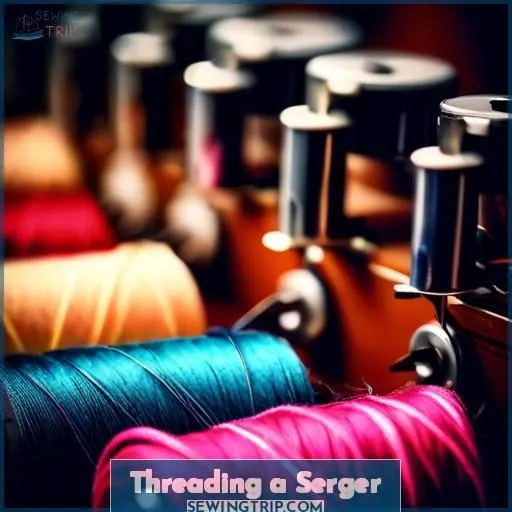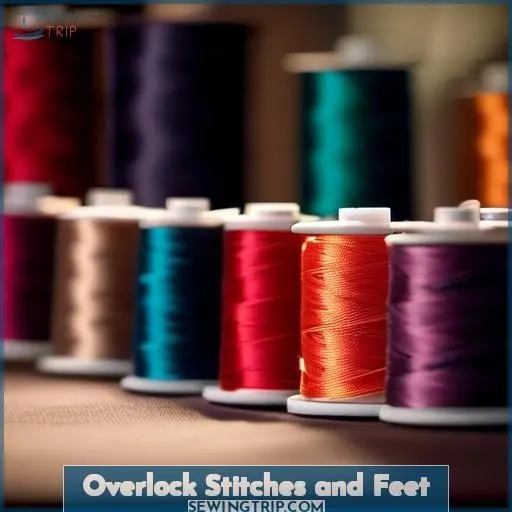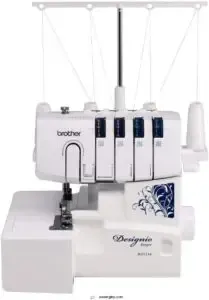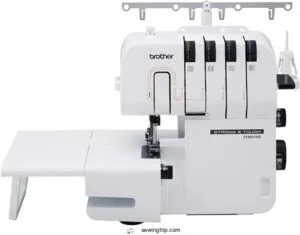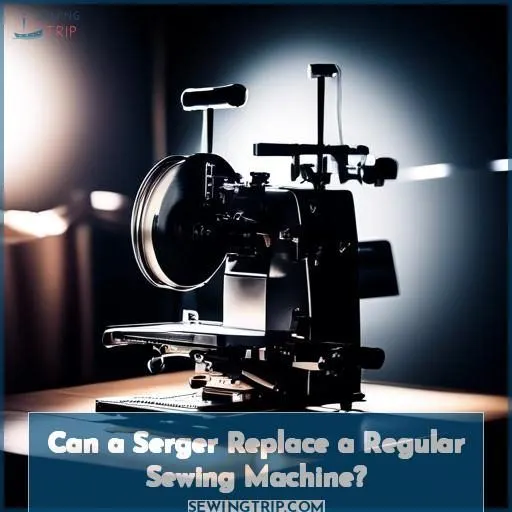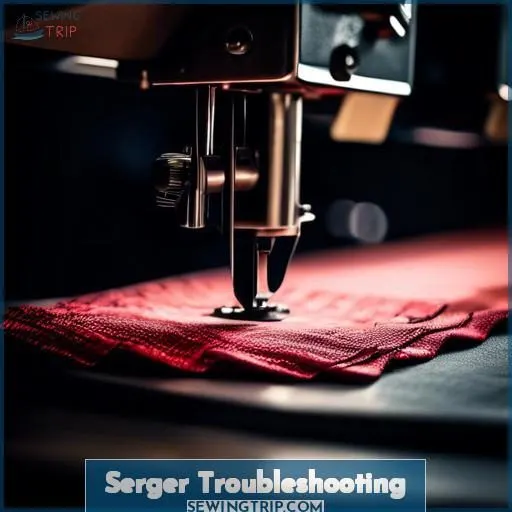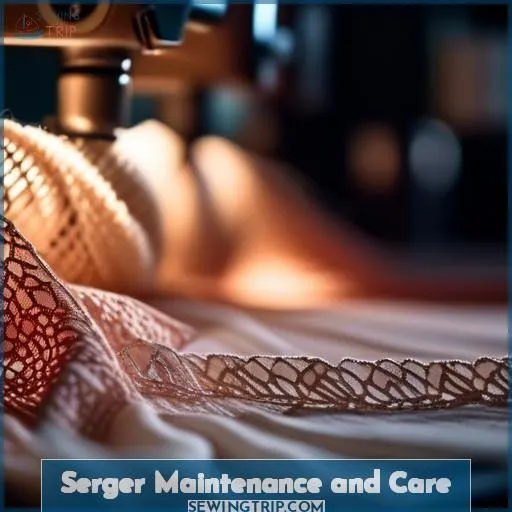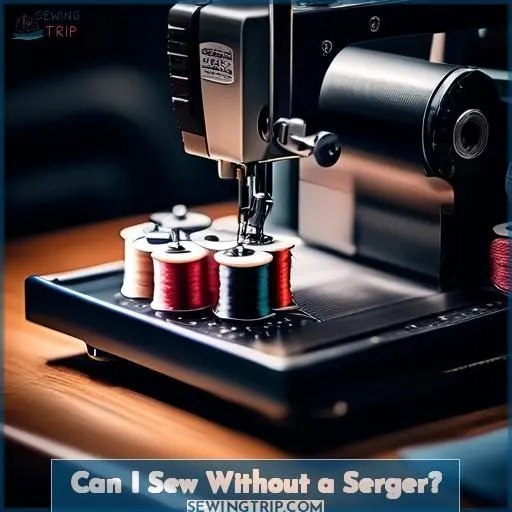This site is supported by our readers. We may earn a commission, at no cost to you, if you purchase through links.
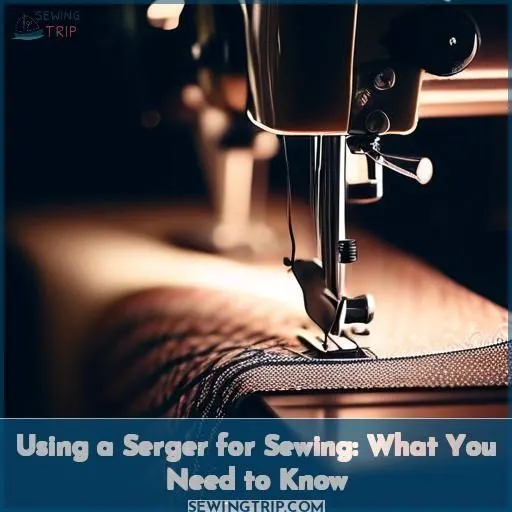
Yes, you can certainly use a serger for sewing.
These specialized machines are intended to create overlock stitches, providing durability and versatility for various fabrics and projects.
While a serger cannot fully replace a sewing machine, it complements it ideally.
With its ability to neatly finish seams, create decorative effects, and handle multiple thread cones simultaneously, a serger expands your sewing possibilities.
However, mastering its threading process and adjusting tensions for different fabrics requires practice.
If you’re prepared to explore the realm of overlock stitching and transform your sewing experience, delve into the thorough guide that follows.
Table Of Contents
- Key Takeaways
- Can You Use Serger for Sewing?
- What is a Serger/Overlocker?
- Serger Thread Characteristics
- Threading a Serger
- Overlock Stitches and Feet
- Top 5 Serger Sewing Machines to Consider
- Can a Serger Replace a Regular Sewing Machine?
- Serger Troubleshooting
- Decorative and Creative Uses for Sergers
- Serger Maintenance and Care
- Can I Sew Without a Serger?
- Frequently Asked Questions (FAQs)
- Conclusion
Key Takeaways
- Sergers, also known as overlockers, are specialized sewing machines designed for creating overlock stitches that seal fabric edges, offering speed, versatility, and the ability to handle different fabrics and stitch types.
- While sergers cannot fully replace regular sewing machines due to their specific functions like seaming and edge finishing, they complement them by providing durability and professional-looking results for various sewing projects.
- Mastering the threading process and adjusting tensions for different fabrics is essential when using a serger, as it requires practice to efficiently utilize its capabilities for both practical and decorative sewing tasks.
- Sergers are beneficial for sewing enthusiasts looking to expand their sewing possibilities with durable seams, decorative effects, and the ability to work with multiple thread cones simultaneously, enhancing the overall quality and finish of sewing projects.
Can You Use Serger for Sewing?
Yes, you can use a serger for sewing, especially for knit fabrics and finishing edges, but it’s not ideal for all sewing projects due to its limited stitch variety.
What is a Serger/Overlocker?
Are you curious about what a serger or overlocker is and how it can benefit your sewing projects? These versatile machines excel at seaming, finishing, and creating professional-looking results – all in one efficient step. Read on to discover the key features and advantages of incorporating a serger into your sewing repertoire.
Overview of Serger Vs. Overlocker
A serger, also known as an overlocker, is a specialized sewing machine designed to create overlock stitches that seal the edges of fabric.
It offers several advantages over regular sewing machines, such as speed, needle types, thread color options, and reduced noise levels.
Sergers can be equipped with various attachments to handle different fabrics and stitch types.
Understanding the discrepancies between sergers and sewing machines is vital for selecting the right tool for your sewing projects.
Key Features and Functions
Regarding serger thread, certain crucial characteristics and functions warrant examination. Serger thread typically exhibits reduced strength compared to standard thread, with a Tex size of T-27 (versus T-34 for standard thread). It often consists of two plies, unlike the three-ply construction of regular thread. This variation in ply count influences the thread’s durability and compatibility with sewing machines.
Most household sewing machines are capable of handling thread up to T-50, however, employing serger thread may lead to tension problems due to its finer structure and distinct weave. To facilitate the connection of serger thread to a sewing machine, a thread stand may be utilized. Spool holders can also enhance the seamless unwinding of serger thread.
Serger thread can generate seams that visually resemble those produced by standard thread, but its suitability for projects prioritizing strength is questionable. Conversely, it can be effectively employed for decorative purposes. experimentation is advisable to identify the optimal serger thread for specific projects.
Benefits of Using a Serger
Venturing into the realm of sergers unveils a treasure chest of possibilities. With a serger, you’re not merely sewing; you’re forging durability into every seam.
Envision transforming any fabric into a masterpiece, courtesy of the serger’s versatility. From elegant decorative effects to ingenious project ideas, the odyssey is as fulfilling as the destination.
Fear not, threading your serger becomes second nature with the appropriate resources.
Serger Thread Characteristics
Curious about how serger thread compares to regular thread? You’ll be interested to know that serger thread is generally weaker and thinner, which can impact its compatibility with regular sewing machines. But don’t worry – there are ways to test it out and see if it works for your projects.
Strength Comparison to Regular Thread
Serger thread is generally weaker than regular thread, but it has its own unique characteristics and uses. Here are three key points about serger thread:
- Thread Weight and Tex Size: Serger thread is typically thinner or finer than regular thread, with a Tex size of T-27, while regular thread usually has a Tex size of T-34.
- Strength Comparison: In straight-stitched seams, Maxi-lock serger thread tore apart most easily, while Surelock serger thread and Gutermann regular thread had similar strength. However, serged seams with Maxi-lock thread didn’t break, but the fabric ripped instead.
- Compatibility with Fabrics: Serger thread is suitable for projects where strength isn’t a major concern and can be used to create decorative effects. It’s also designed to avoid creating bulky seams and is generally thinner or finer than regular sewing machine thread.
When using serger thread on sewing machines, it’s essential to evaluate the thread’s compatibility and potential tension issues. A thread stand can be used to connect serger thread to a sewing machine, and spool holders can enhance the smoothness of serger thread unwinding.
Compatibility With Sewing Machines
Serger thread is generally weaker than regular thread, which might cause tension issues on sewing machines. Most home sewing machines can only handle thread up to T-50, while serger thread has a Tex size of T-27. However, serger thread can be used on sewing machines with the help of a thread stand or spool holders, which improve the smoothness of serger thread unwinding.
To test serger thread on sewing machines, you can use a thread stand to connect the serger thread to the machine. Spool holders can also be used to improve the smoothness of serger thread unwinding. Serger thread can produce seams that are visually comparable to regular thread, but it may not be as strong. In straight-stitched seams, Maxi-lock serger thread tore apart most easily, while Surelock serger thread and Gutermann regular thread had similar strength. Serged seams with Maxi-lock thread didn’t break, but the fabric ripped instead.
Although serger thread may not be suitable for projects where strength is a major concern, it can be used to create decorative effects. Experimentation is recommended to determine the best serger thread for specific projects.
Testing Serger Thread on Sewing Machines
Testing serger thread on sewing machines can be a bit tricky, but with the right tools and techniques, you can achieve good results. Here are some tips to help you get started:
- Thread Stand Use: A thread stand can be used to connect serger thread to a sewing machine. This stand allows you to wind the thread onto your machine’s spools efficiently and securely.
- Spool Holder Efficiency: Spool holders can improve the smoothness of serger thread unwinding. These holders are designed to keep the thread taut and prevent it from tangling, which can help maintain consistent tension throughout the sewing process.
- Decorative Serger Effects: Serger thread can produce seams that are visually comparable to regular thread. In fact, using decorative serger threads can add a unique touch to your projects, such as Maxilock Stretch, Candlelight, and Pearl Crown Rayon.
- Project Strength Considerations: Serger thread may be suitable for projects where strength isn’t a major concern. For example, if you’re working on a project that doesn’t require heavy-duty seams, serger thread can be a good choice.
- Air Threader: If you find threading your serger machine challenging, consider using an air threader. This tool can make the threading process easier and more efficient.
- Upper and Lower Looper: Make sure your serger machine’s upper and lower loopers are properly adjusted. Improper looper tension can lead to uneven stitching and tension issues.
- Tension Disc: Adjust the tension disc on your serger machine to ensure the correct thread tension. This disc controls the amount of friction on the thread as it passes through the machine, which can affect the overall quality of your stitching.
- Differential Feed Settings: If you’re experiencing tension issues, check your differential feed settings. These settings help control the feeding of the fabric through the machine and can affect the thread tension.
Threading a Serger
Threading a serger may seem intimidating, but it’s not as difficult as it looks. Follow the color-coded guides and consider using an air threader to make the process smoother and easier.
Step-by-Step Guide
To thread a serger, start by identifying the serger needle types and their corresponding needles. Next, consider fabric compatibility and adjust tension settings.
Explore decorative stitch options, such as hemming techniques like straight stitch, zig-zag stitch, and rolled hem. Familiarize yourself with specialty stitch functions to enhance your sewing projects.
Color-Coded Guides
Color coordination isn’t just for your wardrobe; it’s a lifesaver when threading your serger. Here’s how:
- Match the Thread to the Guide: Each color-coded guide corresponds to a specific thread path, simplifying the setup.
- Follow Sequentially: Start with the color indicated for the first thread, reducing the chance of crossed threads or missed seams.
- Enhance Usability: For beginners, this system turns an intimidating task into a manageable one, boosting confidence and ensuring your serger sewing starts smoothly.
Using an Air Threader
Utilizing an air threader revolutionizes the task of threading a serger. It simplifies the process and eliminates manual threading, providing relief for users with limited dexterity or vision issues. Air threading machines vary in their offerings and benefits, making it crucial to take into account these factors when making a purchase.
Air threading machines offer numerous advantages. They conserve time and effort by removing the need to memorize the looper and needle threading sequence, as the order is inconsequential on most self-threading sergers. In the event of a thread breakage, only the affected thread requires rethreading, not the entire set. Furthermore, air threading machines are engineered to enhance user-friendliness, featuring a reduced number of threading steps and a more streamlined setup process.
When evaluating an air threading serger, consider the following aspects:
- Ease of operation: Seek machines that are effortless to thread and operate, incorporating features such as automatic thread supply systems and programmable foot controllers.
- Tension adjustments: Verify that the machine provides adjustable tension settings to adapt to various fabrics and stitching requirements.
- Stitch options: Review the range of stitch options offered, encompassing overlock, overedge, double overlock, pin, and ladder stitches.
- Speed: Examine the maximum serging speed to ensure alignment with your sewing needs.
- Cost: Compare prices and determine if the advantages of air threading justify the investment.
Some well-known air threading sergers include the Juki MO-3000QVP, Baby Lock Eclipse DX, and Brother AIRFLOW 3000. These machines present a variety of features and benefits, necessitating thorough research and comparison before making a purchase.
Overlock Stitches and Feet
Wonder which overlock stitches you can create with your sewing machine? The overlock foot can help you replicate some serger-like stitches, though they may not be an exact match. Take a look at the different overlock stitch options and test results to see how they compare.
Types of Overlock Stitches
Overlock stitches come in various types and can be used for different purposes. The most common overlock stitch is the 4-thread overlock, which uses both loopers and both needles, creating a strong and flexible seam suitable for knits. A 3-thread overlock is another option, using only one needle and providing more flexibility for seaming light to medium weight fabrics or knits. A 2-thread overlock is less bulky and is ideal for finishing edges. Additionally, there are variations such as the 4-thread overlock wide (LN) and narrow (RN), 3-thread overlock wide (LN) and narrow (RN), 2-thread overlock wide (LN) and narrow (RN) .
These overlock stitches can be used for various applications, including general construction, installing elastic, inserting zippers, gathering, sewing binding, and creating piping. The choice of overlock stitch depends on the type of fabric, the desired seam strength, and the specific project requirements.
When using an overlock stitch, it’s essential to adjust the tension settings and stitch length according to the fabric and thread choice. Overlock stitches can be adjusted by changing the needle tension, looper tension, or the stitch width.
For beginners, it’s recommended to practice with different overlock stitches and settings to achieve the desired results. Overlock stitches can be used to create professional-looking seams and edges, enhancing the overall quality of sewing projects.
Overlock Foot Compatibility
When employing an overlock foot, it’s crucial to evaluate the space around the bar situated in the foot’s center. This bar guarantees that the length and width of the stitch align with the fabric being sewn. To assess the stitch width for clearance, sew a sample with the overlock foot, adjusting the stitch length and width as necessary.
Overlock stitches, including overlock stitch (number 10), overedge stitch (number 11), double overlock stitch (number 14), pin stitch (number 17), and ladder stitch (number 19), can reasonably approximate a serged edge when using an overlock foot. However, it’s worth noting that an overlock foot can’t perfectly replicate a serged edge. With patience and practice, you can achieve a close approximation of a serged edge using an overlock foot.
When comparing the pin and ladder stitches to a serged edge, the pin and ladder stitches resemble the serged edge but have less flexibility than the overedge and double overlock stitches. The pin and ladder stitches have a stitch length of 1.5 and appear best with reduced tension. Ladder stitch, in particular, looks best with reduced tension.
Test Results and Comparisons
Testing serger thread on sewing machines can reveal interesting results. For instance, a thread stand can be used to connect serger thread to a sewing machine, and spool holders can improve the smoothness of serger thread unwinding.
However, serger thread may cause tension issues on sewing machines. To overcome this, you can experiment with different thread tensions and stitch lengths.
Additionally, decorative serger stitches can be used to create unique effects, and serger foot compatibility is essential for achieving wave-free and pucker-free seams.
For those interested in learning more, free online sewing classes can provide valuable insights into thread tension optimization and stitch length impact.
Top 5 Serger Sewing Machines to Consider
Are you seeking a high-quality serger? Consider these 5 exceptional choices – the Brother Overlock Sewing Machine DZ1234, Juki Portable Thread Serger Sewing Machine, Juki MO644D Portable Serger Machine, Singer Professional Serger Overlock Machine, and Brother ST4031HD Serger Overlock Machine. Each of these sergers boasts impressive features and capabilities to enhance your sewing experience.
1. Brother Overlock Sewing Machine DZ1234
When eyeing the Brother Overlock Sewing Machine DZ1234, you’re looking at a sturdy companion for your sewing adventures. This metal-framed marvel stitches at a brisk pace of 1,300 per minute, letting you race through projects with ease.
Its adjustable stitch width and color-coded guides mean you’ll spend less time fiddling and more time creating. And with accessory feet like the blind hem stitch and gathering, it’s like having a Swiss Army knife for fabric.
Just remember, while it’s a whiz at serging, it won’t replace your regular sewing machine for every task. Keep it oiled and clean, and it’ll be a trusty sidekick in your quest for sewing mastery.
Best For: Seamstresses and crafters looking for a high-speed, versatile serger.
- Fast stitching speed of 1,300 stitches per minute
- Adjustable stitch width and color-coded thread guides
- Includes accessory feet for specialized tasks
- Not intended for heavy-duty sewing
- Old-fashioned light bulb
- May be difficult to work with L-shaped edges
2. Juki Portable Thread Serger Sewing Machine
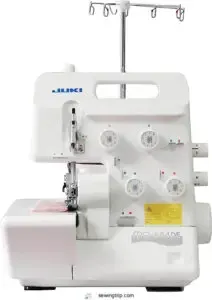
The Juki Portable Thread Serger Sewing Machine is a powerful and versatile tool for sewing enthusiasts. With a maximum sewing speed of 1500 stitches per minute (spm), it can handle a wide range of light to heavy weight fabrics, including multiple layers of thick fabric with ease. This serger is compact and lightweight, making it easy to move and carry around.
One of the standout features of the Juki Portable Thread Serger Sewing Machine is its 2/3 thread converter, which allows you to use two or three threads for different stitch modes, such as flatlock, rolled hem, and sewing in tape. It also has a differential feed feature, which allows you to control the speed of the dog feed and avoid puckering or stretching fabrics.
Threading the Juki Portable Thread Serger Sewing Machine is relatively easy, thanks to its color-coded guide and the lower looper, which slides to the right when you push on the white lever, making it easier to thread. The machine comes pre-threaded to make threading easier for the first time, and the tension dials are all on the face of the machine, making it simple to adjust.
Cleaning and oiling the Juki Portable Thread Serger Sewing Machine is also straightforward, with two doors that make it easy to access the moving parts for cleaning with a lint brush. The motor is concealed, allowing you to use a can of compressed air safely to remove lint.
Best For: Sewing enthusiasts looking for a portable and powerful serger for handling a wide range of fabrics with ease.
- Versatile 2/3/4 thread serger with automatic rolled hem and thread cutter
- Easy threading with color-coded guide and breakaway looper
- Adjustable stitch length and differential feed for precise control
- No bright LED light
- May require extra feet for specialized stitches (sold separately)
- Does not have a coverstitch
3. Juki MO644D Portable Serger Machine
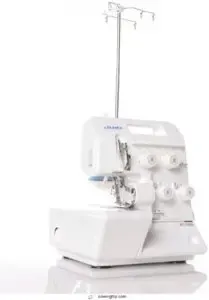
The Juki MO644D is a versatile and affordable 2-needle, 2/3/4 thread serger that’s perfect for both beginners and experienced sewers. It features built-in rolled hemming and differential feed, making it ideal for creating a wide range of projects, from simple sportswear to elegant evening wear.
The MO644D is known for its exceptional stitch quality and ease of use, making it a popular choice among sewers looking for a reliable and efficient serger.
Best For: Beginners and experienced sewers looking for a versatile and affordable serger.
- Exceptional stitch quality
- Easy to use
- Wide range of features
- Requires good quality cone threads
- Instructions should be read carefully when threading for the first time
- Oil machine per instructions
4. Singer Professional Serger Overlock Machine
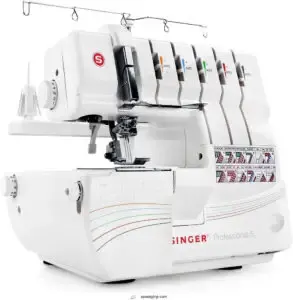
The Singer Professional 5 Serger Overlock Machine is a high-quality and versatile sewing machine that offers a range of features for sewing enthusiasts. This machine is designed for professional use and can handle a variety of projects, from garments to home decor. With 5/4/3/2 thread capability, it provides a wide selection of stitch options for all types of projects, ensuring professional results every time. The machine sews at 1,300 stitches per minute while trimming and overcasting, allowing you to zip through projects in no time.
One of the key benefits of the Singer Professional 5 Serger Overlock Machine is its adjustable cutting width, stitch length control, and self-adjusting tension system. These features allow for creative freedom and easy set-up, making it suitable for various fabric types and sewing techniques. The machine also includes six presser feet and an easy threading diagram, making it easy to use for beginners and experienced sewers alike.
Another advantage of this serger is its 25-year Limited Warranty, which covers parts and labor for the machine. Additionally, it comes with a range of accessories, including a workbook, needles, and an instruction manual, to help you get started with your sewing projects.
Best For: Experienced sewers and professionals looking for a high-performance and versatile serger for a range of projects.
- 5/4/3/2 thread capability for professional-looking results
- 1,300 stitches per minute for fast and efficient sewing
- Adjustable cutting width, stitch length control, and self-adjusting tension system for easy customization
- Limited 90-day warranty for adjustments and accessories
- Relatively expensive compared to other sergers on the market
- Can be complex for beginners to use
5. Brother ST4031HD Serger Overlock Machine
The Brother ST4031HD serger is a heavy-duty, 3-4 thread serger designed for tackling heavy-duty projects with ease. It boasts a maximum sewing speed of 1,300 stitches per minute and is backed by a 25-year limited warranty with free technical phone support for the life of the product.
This serger is ideal for working with multiple layers of denim, layered knits, and heavy-duty fabrics, thanks to its strong interior metal frame and high-durability blade made from extra hard carbon steel.
The Brother ST4031HD is easy to thread, with color-coded guides and a metal thread stand for smooth thread feeding. It also includes a wide table and large extension table to accommodate heavy fabrics and prevent excess pulling on the needle and thread.
The serger comes with standard, blind stitch, and gathering feet, providing versatility for various stitching needs.
Best For: Home sewers and professionals who want a durable and heavy-duty serger for working with thick and multiple layers of fabric.
- Durable, heavy-duty construction
- Easy to thread and use
- Handles thick materials with ease
- Flimsy thread stand
- May not be suitable for beginners
- Faster speed than other lower Brother models
Can a Serger Replace a Regular Sewing Machine?
While sergers and sewing machines serve different purposes, they can actually complement each other quite well. You’ll want to carefully consider the key differences between the two machines and how they might suit your specific sewing needs before deciding which one to invest in.
Differences Between Sergers and Sewing Machines
Sergers, or overlockers, are the ninjas of the sewing world—swift and precise. They differ from sewing machines with their looped stitches and knack for handling fabric edges like a pro.
While you’re learning to sew, remember that sergers excel in speed and decorative possibilities, but they might grapple with compatibility issues and thread strength, making troubleshooting a handy skill in your sewing arsenal.
Complementary Uses for Both Machines
A serger can be a valuable addition to your sewing arsenal, but it doesn’t necessarily replace a regular sewing machine. Both machines have their unique strengths and uses.
A serger excels at seaming fabric and covering raw edges, creating a professional appearance. It’s versatile and can handle stretchy fabrics. However, it may not be suitable for all projects, especially those that require high strength or precision.
Regular sewing machines are essential for tasks like buttonholes, hems, and sewing with heavier fabrics. The key is to understand the complementary nature of both machines and use them accordingly.
Considerations for Choosing Between Them
When deciding whether a serger can replace a regular sewing machine, consider the strength, compatibility, and testing of serger thread. Serger thread is generally weaker and may cause tension issues on sewing machines. It may not be suitable for all projects, but experimentation can help determine the best serger thread for specific projects.
Serger thread may be suitable for projects where strength isn’t a major concern, or for creating decorative effects. However, both machines serve different purposes and can complement each other in your sewing projects.
Serger Troubleshooting
Adjusting the tension on your serger is essential when sewing different fabrics. If you encounter common issues like skipped stitches or thread breakage, don’t hesitate to seek professional assistance to get your serger running flawlessly again.
Adjusting Tension for Different Fabrics
When using a serger, it’s essential to adjust the tension settings for different fabrics to get the best results. For heavier fabrics, increase the tension, while for lighter ones, decrease it.
Stretch fabrics may need a different tension setting, and seam allowances should be adjusted accordingly.
Additionally, consider the type of stitch you’re using, as decorative stitches may require different tension settings.
Keep a note of your settings for each fabric to maintain consistency in your sewing projects.
Common Issues and Solutions
Facing tension problems or thread breakage? It’s often a threading hiccup. Make sure you’re threading in the correct sequence – it’s a significant difference.
Fabric puckering? Change the tension dials.
Poor stitch quality can usually be traced back to mismatched needle and thread sizes.
Seeking Professional Assistance
When you encounter issues with your serger, seeking professional assistance can be a valuable resource. Here are some tips for troubleshooting:
- Serger Repair: If your serger is malfunctioning, consider taking it to a professional for repair. They can diagnose the issue and provide a solution, such as replacing parts or adjusting settings.
- Tension Adjustment: If your serger is producing uneven stitches, it may be due to incorrect tension settings. Consult your machine’s manual or a professional to ensure proper tension adjustment.
- Threading Assistance: If you’re struggling with threading your serger, consider using a threader tool or seeking help from a sewing instructor. They can guide you through the process and help you avoid common mistakes.
- Maintenance Tips: Regular maintenance, such as cleaning and oiling your serger, can prevent many issues. A professional can provide guidance on the best practices for maintaining your machine.
- Creative Inspiration: If you’re looking for new ideas for your serger projects, consider attending a sewing workshop or consulting with a professional designer. They can provide inspiration and guidance on using your serger for various decorative and functional applications.
Decorative and Creative Uses for Sergers
Sergers aren’t just for practical seams – you can use them to add decorative and creative touches to your projects. Explore techniques like decorative edging, embroidery, and even attaching trims and lace to elevate the look and feel of your handmade items.
Finishing Techniques
Delight in the artistry of serger seam strength as you explore decorative stitching possibilities. Serger fabric compatibility opens up a world of creative potential. Adjust serger thread tension to your liking for a seamless finish. Discover the various stitch types that can elevate your projects. Display your creativity with serger finishes that are sure to impress.
Embellishment and Embroidery
Liberate your imagination with serger embellishments! From ornamental stitches to exceptional threads, your sewing endeavor can metamorphose into a masterpiece. Tweak thread tension to your preferred level for an immaculate finish. Venture into the realm of diverse creative muses for a singular flourish in your sewing.
Exploring Serger Capabilities
After delving into the realm of embellishment and embroidery, let’s not overlook the serger’s aptitude for extending creative limits. With its exceptional thread strength and stitch adaptability, your serger can craft ornamental finishes that captivate.
However, remember, proficiency with this tool entails familiarity with troubleshooting techniques and regular maintenance. It’s not merely about creating a statement; it’s about ensuring its endurance.
Serger Maintenance and Care
To keep your serger running smoothly, it’s important to clean and oil it regularly. Don’t forget to sharpen the blades periodically and store or transport your serger with care to protect its intricate mechanisms.
Cleaning and Oiling
Maintain your serger’s optimal performance through consistent cleaning and lubrication. For cleaning, utilize a serger cleaning kit equipped with brushes and compressed air. Lubrication frequency varies based on usage, but a practical guideline is every 20 hours. Establish a regular maintenance schedule and promptly address cleaning concerns. Bear in mind that a well-maintained serger guarantees effortless stitching and extends its longevity.
Blade Sharpening
After thoroughly cleaning and lubricating your serger, it’s crucial to focus on blade maintenance. Maintaining sharp blades not only prolongs their life but also guarantees that your projects are cut seamlessly. Whether you choose professional blade sharpening or recognize when replacements are necessary, understanding blade care is essential for optimizing your serger’s performance.
Storage and Transportation
Serger storage and transportation are essential aspects of serger maintenance and care. Here are three tips to help you manage your serger effectively:
- Proper Storage: Invest in storage solutions designed for serger cones, such as ArtBin inserts or covered plastic bins. These options keep your threads organized, visible, and easily accessible.
- Portability: Consider purchasing a portable serger if you frequently travel or need to sew on the go. Portable sergers are lightweight and compact, making them ideal for sewing projects away from home.
- Maintenance and Care: Regularly clean and oil your serger to ensure optimal performance. Blade sharpening is also essential for maintaining the quality of your stitches.
Can I Sew Without a Serger?
If you’re wondering if you can sew without a serger, the answer is yes. However, a serger can offer several benefits that make it a valuable tool for sewing, especially when working with knits or other stretchy fabrics. Here are four reasons why a serger can be beneficial:
- Durability: Sergers create strong, balanced stitches that can withstand the stress of stretchy fabrics, ensuring that your seams and hems last longer.
- Affordability: While sergers can be an investment, they’re often more affordable than you might think. There are many options available at different price points, making it possible to find a serger that fits your budget.
- Thread management: Sergers are designed to handle multiple threads, which can be a challenge when using a regular sewing machine. This makes serging a more efficient process, as you don’t have to worry about managing multiple threads manually.
- Stitch quality: Sergers produce high-quality stitches that can enhance the look of your projects, especially when working with knits. The overlock stitch created by a serger can provide a professional finish that’s difficult to achieve with a regular sewing machine.
That being said, if you don’t have a serger, there are other methods you can use to finish your seams. For example, you can use a zigzag stitch or a rolled hem stitch on your sewing machine to create a seam finish. Additionally, you can experiment with different techniques, such as French seams or bias tape, to achieve a neat and professional look for your projects.
Frequently Asked Questions (FAQs)
What are the benefits of using a serger instead of a sewing machine for specific projects?
Dear seamstress, you’ll finesse projects with a serger’s prowess for encasing edges impeccably while constructing durable seams expeditiously. Harness the versatility of this versatile tool to unlock your ingenuity.
How does the threading process differ between a serger and a sewing machine?
Threading a serger is trickier, with multiple thread guides you’ll need to follow precisely. But master it, and overlocking becomes a breeze – smooth seams in one zippy pass!
Can a serger be used for quilting projects, and what are the best practices for doing so?
You can use a serger for quilting projects, but it’s not ideal. A serger trims fabric edges, which you don’t want for quilting. Stick to a regular sewing machine and practice your 1/4 seams for the best results.
What are the most common issues that users encounter when using a serger, and how can these be resolved?
The most common serger issues? Threading nightmares, tension troubles, and fabric nests. But don’t sweat it! Grab your manual, take a breath, and methodically retrace each step. With patience and practice, you’ll be serging like a pro in no time.
How does a serger compare to a regular sewing machine in terms of speed and efficiency?
A serger, my friend, is the beeline to efficiency; it’ll knock your socks off with lightning speed sewing that leaves regular machines eating dust. Embrace its power, master its ways – your projects will thank you!
Conclusion
Indeed, practice leads to proficiency in utilizing a serger for sewing.
With its adaptability in completing seams and producing decorative effects, incorporating a serger into your sewing regimen can enhance your projects.
You’ll require commitment to master threading and tension adjustments, but the benefits are well worth the endeavor.
Accept the learning curve, and you’ll swiftly discover that a serger is an essential companion to your sewing machine, expanding your creative potential in the realm of overlock stitching.

